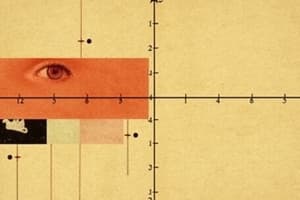Podcast
Questions and Answers
Which of the following is the most important consideration when determining the direction to shade an inequality on a graph?
Which of the following is the most important consideration when determining the direction to shade an inequality on a graph?
- The positivity or negativity of the numbers involved.
- The type of line used (solid or dashed)
- The inequality sign in the expression. (correct)
- The specific values of the x-intercept and y-intercept.
When solving an inequality, which operation necessitates reversing the inequality sign?
When solving an inequality, which operation necessitates reversing the inequality sign?
- Adding a negative number to both sides.
- Multiplying both sides by a positive number.
- Dividing both sides by a negative number. (correct)
- Subtracting a positive number from both sides.
You're graphing the inequality $y < 2x + 1$. Which of the following points would definitely not be in the shaded solution region?
You're graphing the inequality $y < 2x + 1$. Which of the following points would definitely not be in the shaded solution region?
- (3, 3)
- (1, 4) (correct)
- (2, 2)
- (0, 0)
Which statement accurately describes the initial step when graphing the inequality $y
geq -x + 5$?
Which statement accurately describes the initial step when graphing the inequality $y geq -x + 5$?
When graphing an inequality, what does the shaded area of the graph represent?
When graphing an inequality, what does the shaded area of the graph represent?
Which of the following actions would not result in a correct graph of a linear inequality?
Which of the following actions would not result in a correct graph of a linear inequality?
Suppose you incorrectly shade the wrong side of the line when graphing an inequality. What is the most direct consequence of this error?
Suppose you incorrectly shade the wrong side of the line when graphing an inequality. What is the most direct consequence of this error?
You graph the line for an inequality and need to determine which side to shade. Which point would be the easiest to use as a test point, if it's not on the line?
You graph the line for an inequality and need to determine which side to shade. Which point would be the easiest to use as a test point, if it's not on the line?
Which of the following is a valid strategy for graphing the inequality $y > -2x + 3$?
Which of the following is a valid strategy for graphing the inequality $y > -2x + 3$?
When constructing a table of values to graph an inequality, why is choosing x = 0 and y = 0 often recommended?
When constructing a table of values to graph an inequality, why is choosing x = 0 and y = 0 often recommended?
You are solving an inequality and need to isolate $x$. You have the expression $-3x > 12$. What is the next step?
You are solving an inequality and need to isolate $x$. You have the expression $-3x > 12$. What is the next step?
Suppose you graph an inequality of the form $y
leq mx + b$ and find that the point (0, 0) is part of the solution. What does this tell you about the value of 'b'?
Suppose you graph an inequality of the form $y leq mx + b$ and find that the point (0, 0) is part of the solution. What does this tell you about the value of 'b'?
If two different students graph the inequality $y > x + 1$, and each chooses different test points to determine which side to shade, what will happen?
If two different students graph the inequality $y > x + 1$, and each chooses different test points to determine which side to shade, what will happen?
When graphing inequalities, why is it important to use a dashed line for inequalities with '<' or '>' and a solid line for inequalities with '≤' or '≥'?
When graphing inequalities, why is it important to use a dashed line for inequalities with '<' or '>' and a solid line for inequalities with '≤' or '≥'?
Given an inequality in the form $y < ax + b$, how does increasing the slope 'a' affect the shaded region?
Given an inequality in the form $y < ax + b$, how does increasing the slope 'a' affect the shaded region?
You are graphing the system of inequalities: $y > x + 1$ and $y < -x + 1$. Which area represents the solution?
You are graphing the system of inequalities: $y > x + 1$ and $y < -x + 1$. Which area represents the solution?
When preparing to graph the inequality $y
geq 5x - 3$, a student first graphs the line $y = 5x - 3$. They then choose the test point (0,-4). What is the student trying to determine?
When preparing to graph the inequality $y geq 5x - 3$, a student first graphs the line $y = 5x - 3$. They then choose the test point (0,-4). What is the student trying to determine?
How does the solution set of the inequality $y > 2x + 3$ change if the inequality is changed to $y
geq 2x + 3$?
How does the solution set of the inequality $y > 2x + 3$ change if the inequality is changed to $y geq 2x + 3$?
What does graphing the inequality $x > 3$ on the coordinate plane represent?
What does graphing the inequality $x > 3$ on the coordinate plane represent?
Flashcards
Shaded Area in Inequality Graphs
Shaded Area in Inequality Graphs
Graphical representation of solutions to an inequality.
Determining Shading Direction
Determining Shading Direction
Direction based on whether values are greater or less than a point.
Solving Inequalities Graphically
Solving Inequalities Graphically
Treat the inequality as an equal sign for calculations, then shade based on the inequality sign.
Using Tables to Graph (X is Zero)
Using Tables to Graph (X is Zero)
Signup and view all the flashcards
Inequality Sign Reversal
Inequality Sign Reversal
Signup and view all the flashcards
Using Tables to Graph (Y is Zero)
Using Tables to Graph (Y is Zero)
Signup and view all the flashcards
Study Notes
No new information was provided, so the study notes remain the same:
Graphing Inequalities
- When graphing inequalities, numbers greater than one shouldn't include numbers less than negative one.
- On a graph, the shaded area represents the solution to the inequality.
- Shading should be in the opposite direction for inequalities; if the equation is incorrectly shaded with a solid line, it's wrong.
Determining Shade Direction
- To determine shading direction, consider whether values are greater or less than a point on the y-axis.
- Shading direction is determined by the inequality sign, not the positivity or negativity of the numbers, as the sign indicates which way to shade.
Solving Inequalities with Graphs
- Treat the inequality as an equal sign when calculating, then apply the shading based on the inequality.
- If graphing y = 3x - 4, the line remains solid with no shading until the inequality is considered.
Using Tables to Graph
- When X is zero, substitute zero into the appropriate place in the equation and solve for Y.
- When solving inequalities, multiplying or dividing by a negative number reverses the inequality sign.
- Remember earlier content on inequalities when you solve not using graphs
Choosing Points for Graphing
- When Y is zero, substitute zero into the equation and solve for X to complete the table.
- Choosing zero for x and y simplifies calculations, but any number can be chosen.
- Selecting different values for x and y will yield different points, but they will all fall on the same line when graphed.
Studying That Suits You
Use AI to generate personalized quizzes and flashcards to suit your learning preferences.




